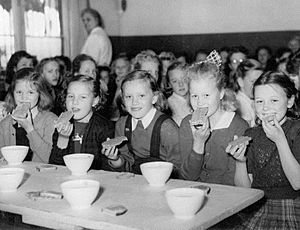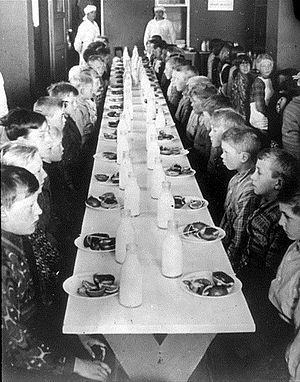Oslo breakfast facts for kids
The Oslo breakfast was a special kind of school meal. It was developed in the 1920s and given for free to all school children in Oslo, Norway, starting in 1932. This meal was usually made up of bread, cheese, milk, half an apple, and half an orange.
The original name in Norwegian was Oslofrokosten, which means "the Oslo breakfast." Professor Carl Schiøtz designed this meal to be super healthy. Studies showed that it really helped children's long-term health. In the 1930s, the Oslo breakfast became famous. Other places in Scandinavia, Europe, and around the world started similar programs. Many of these were small, sometimes just in one school. By the late 1950s, schools mostly stopped serving the Oslo breakfast. Sometimes, they offered hot meals instead, or stopped free meals completely. This happened because people were earning more money, so free school meals seemed less needed.
What Was in the Oslo Breakfast?
The Oslo breakfast usually had these ingredients:
- Two slices of wholemeal bread, like Kneippbrød, with margarine
- A slice of cheese
- About half a pint of milk
- Half an apple and half an orange
Sometimes, extra things were added, like slices of raw vegetables such as carrots or swedes. Between autumn and spring, children might also get a dose of cod liver oil.
The Story of the Oslo Breakfast
One of the first people to suggest school meals was Count Rumford. He helped feed and teach children in Germany in the late 1700s.
Oslo, which was called Christiana back then, started giving hot school meals in 1897. But food scientists, like Axel Holst in 1909, said these meals were not healthy enough. In the 1920s, many people in Norway, including Oslo, were still quite poor. This meant children often didn't get enough good food.
Carl Schiøtz, a professor, created the Oslo breakfast. He used the best science of his time to make it very nutritious. Around 1927, he started saying it should replace the old hot meals. He later shared results from his studies. These showed that children who ate the Oslo breakfast gained more weight than those who had the hot meal, especially if they were underweight.
Professor Schiøtz was also an important official in Oslo's city government. This helped him make his ideas happen. By 1932, all primary school children in Oslo were getting the Oslo breakfast. Later, older children also received it. It was given free to everyone. This was important so that poor children wouldn't feel different or ashamed if they had to ask for a free meal.
The Oslo breakfast was the most famous of many efforts in the 1920s and 1930s. Governments and schools around the world wanted to give children healthier food. Another famous example was Lord Boyd-Orr's work in Scotland. He showed how good it was to give school children free milk. This led to free milk for all school children in Scotland, and later in all of Great Britain.
From the 1930s to the 1950s, programs like the Oslo breakfast spread. They went to other Norwegian cities, across Scandinavia, through Europe, and even to places like Australia and Canada. For example, Jack Drummond from London University said the results were "remarkable" after 130 poor children ate the breakfast. The children's skin problems improved, and they grew 25% taller than children who didn't have the breakfast.
The Oslo breakfast was most popular around the mid-1950s. Then, its popularity started to go down. In some places, it was an extra meal, not a replacement for lunch. Schools found that running two meal programs took too much time away from teaching. So, they often chose to stop the breakfast instead of the more popular lunch. In the late 1950s, the Oslo breakfast stopped being served in Norway. Norway was much richer by then, and the government felt there was no need for free school meals anymore. Norwegian parents then started packing lunches for their children, often with similar healthy ingredients to the original breakfast.



